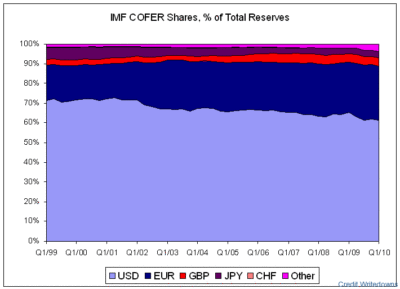Central Bank Reserves: IMF COFER Data Shows Little Change
From BBH’s Win Thin
The IMF just released its quarterly report on currency shares of global reserves. In Q1 10, the dollar’s share fell slightly to 61.5% from 62.2% in Q4, while the euro’s share fell to 27.2% from 27.3% in Q4 and sterling’s was steady at 4.3%. These changes were nearly imperceptible, but who gained? The yen share ticked up to 3.1% from 3.0% in Q4, but the catch-all “Other” category showed an increase in its share to 3.7% from 3.1% in Q4. This contains AUD, CAD, and NOK and so the numbers do feed into the story line that central banks have been diversifying more into the dollar bloc and Scandies. However, we again caution that only 55.6% of total global reserves are broken out into currencies, with the remaining 44.4% remaining “unallocated” (this category includes China, the largest holder of reserves that account for about 30% of total global reserves). This is the highest proportion of unallocated reserves on record and has risen steadily from about 20% back in 1997. China is the big driver in the rise in unallocated reserves, as it does not report its reserve breakdown even as its reserve holdings have jumped to $2.5 trln at the end of Q1 from less than $100 bln at the end of 1996. It is thought to hold about two thirds of its reserves in dollars.
As we highlighted in our COFER preview earlier this week, we did not expect major changes in the Q1 reserve composition and that basically turned out to be true. Q2 reserves are going to be more difficult to get a handle on for several reasons. First, the SNB was very actively intervening in Q2, and in May alone appears to have bought something around EUR 55 bln. Second, the European debt crisis is going to have major impact. There has been much talk in recent weeks that central banks in Asia and the Middle East may have boosted sterling reserve holdings. There has also been talk that the European debt crisis is causing reserve managers to avoid peripheral euro zone bonds, which were used in the past to augment returns. This would weigh on the euro share of world reserves, and should show up more in Q2 data. Looking ahead, we look for an increase in the dollar’s share of global reserves in Q2. Sterling’s reserve status may also have been enhanced by the European debt crisis, and so sterling and the "Other" category could also show increases in Q2 at the expense of the euro’s share.
Win Thin
Senior Currency Strategist
Brown Brothers Harriman & Co.

Comments are closed.